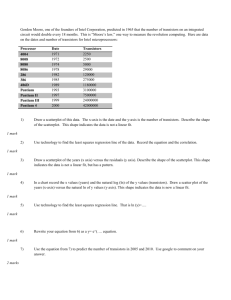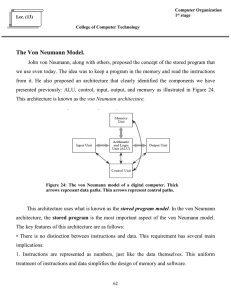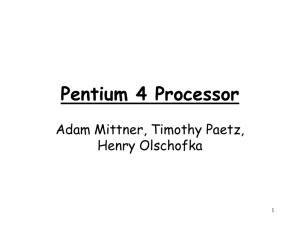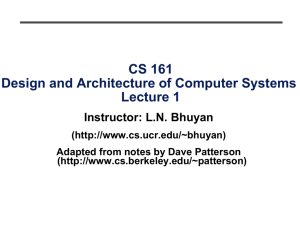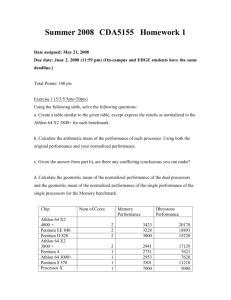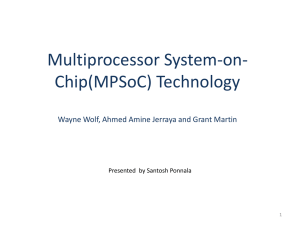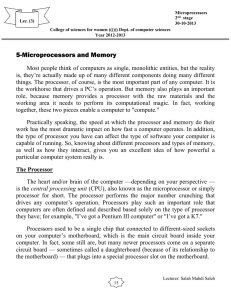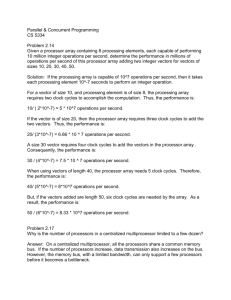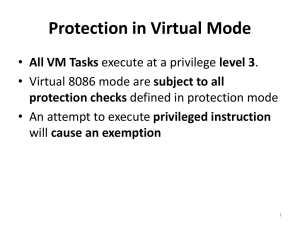Lecture 1
advertisement
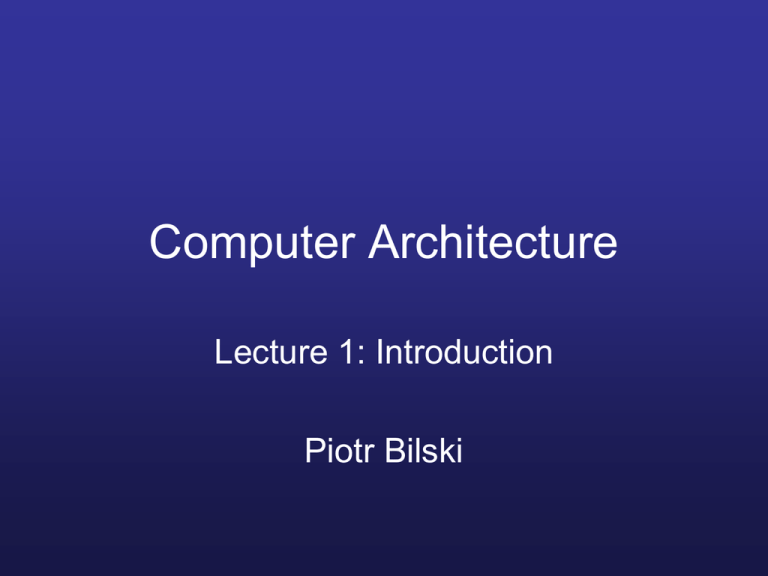
Computer Architecture Lecture 1: Introduction Piotr Bilski Plan of the Lectures 1. 2. 3. 4. 5. 6. 7. 8. 9. 10. 11. 12. 13. 14. Introduction, history of the computers, Moore's Law Structure of the computer system. System bus. Orders' cycle Logical systems. Computer's arithmetics Processor's instruction list Structure and work regime of the processor Control Unit Cache memory Internal and external memory Input/output devices Operating system support RISC processors Superscalar processors Parallel architectures IA-64 architecture Points and Grades Two tests during the semester: 50 points MAX Two programming projects: 50 points MAX 26 pts – grade 3 31 pts – grade 3,5 36 pts – grade 4 41 pts – grade 4,5 46 pts – grade 5 References W. Stallings, “Computer Organization and Architecture. Designing and Performance. 7th Edition”, Prentice Hall, 2006. A.J. van de Goor, “High Performance Computer Architecture,” Prentice-Hall, 1989. B. Wilkinson, Computer architecture (2nd ed.); Prentice-Hall 1996. Hennessy, J.L. Patterson, Computer architecture – a quantitative approach (3nd ed.); Morgan Kaufman 2005. J. Silc, B. Robin, T. Ungerer, Processors architecture: from dataflow to superscalar and beyond; Springer-Verlag 1999. Organization and Architecture of the Computer System • Organization determines operational units and connections between them, which realize architecture • Architecture describes attributes (characteristics) of the computer system, visible (accessible) for the programmer Definition of the Computer • Computer is, in general meaning, computing machine, used for processing of the information represented in the digital form or as the continuous signal • What is the difference between the calculator and the computer? Classification of the Computers Size of the instruction set RISC CISC Method of the data processing Serial (scalar) Parallel Matrix Application Vector Universal Multiprocessor Problem-oriented Specialized Breadth of the address bus 8-bit 32-bit 16-bit 64-bit Functional Scheme of the Computer Environment Data processing with transmission Data transmission Transfer data module Internal processing of data Data storage Data storing module Control module Data processing module Phases of the Computer Development 1. Computers based on the vacuum lamps (19461957) 2. Transistor-based computers (1958-1964) 3. SSI, MSI structure-based computers (19651971) 4. LSI structure-based computers (1972-1977) 5. VLSI structure-based computers (1978-??) 6. New architectures: molecular, quantum, optical, neurocomputers Phases of the Processor Development (Intel) 1. 2. 3. 4. 5. 6. 7. 8. 9. 8-bit processors (8086-80188) 16-bit processors (80286) First 32-bit processors (80386) 486 family (80486) Pentium family (80586) Pentium Pro family (80686) Pentium IV family 64-bit processors (Pentium IV Extreme) Multicore processors (Dual Core, Core2Duo, Core2Quad, X2, X4, i7) Pentium and PowerPC • Pentium: • PowerPC: – Manufactured by – Manufactured by Intel IBM-Apple-Motorola – Classical superscalar – The best RISC representative of the processor x86 architecture – Models: 601, 603, – Pentium, Pentium II, 604, 620, G3, G4 Pentium Pro, Pentium – Currently installed in IV, IA-64 (64-bit!) the network devices, printers (Kyocera) and consoles (PS3, Nintendo Wii) ENIAC (J.P. Eckert, J.W. Maulchy - 1946) • Considered (erroneously) as the first computer in the world • Calculations in the decimal system (no memory) • Weight – 30 tons, 20 thousand of the vacuum lamps inside, 5000 op/s, power required: 140 kW • Applications: calculations for the military (missiles ballistics, viability to construct the hydrogen bomb) Commercial Computers (since 1951) 701, 702 (IBM) UNIVAC I (SperryRand Corporation) Characteristics: Central Processing Unit (CPU) based on the vacuum lamps Operational memory based on the ferrite rings or electrostatic lamps The First Microprocessor (1971) • Developed in the Intel company, labelled as 4004 (author: Ted Hoff) • Built from 2300 transistors • Impemented operation of adding two 4-bit numbers • 100 kHz clock The First General Purpose Processor (1974) • • • • • Signature: 8080 8-bit processor Clock speed: 2 MHz 6000 of transistors in the circuit 64 kB of addressable memory Apple II Computer (1977) • The first one to present the colour graphics • Open architecture (easy to expand) • MOS 6502 processor (1MHz to 3 MHz) • RAM memory 4KB, max. 64 KB • WOZ Integer Basic operating system IBM PC/XT Computer (1983) • Intel 8088 processor (4,77 MHz), later (in the turbo mode) to 14 MHz • RAM memory – max. 640 kB • 8-bit ISA bus • Later replaced by IBM PC/AT and IBM PC/XT/286 Moore’s Law (1965) Gordon Moore (born in 1929, San Francisco, California), PhD in physics in 1954 r. One of the founders of the Intel corporation in 1968 r. „Economically optimal number of the transistors in the integrated chip will be doubled every 18 months” „Computational power of the microprocessors will be doubled every 18 months, assuming constant production cost” Moore's Law (cont.) • Original drawing from Moore's paper (1965) Moore’s Law (cont.) Processor's clock [MHz] 10000 1000 100 10 1 1970 0,1 1975 1980 1985 1990 1995 2000 2005 2010 2015 years „If the car technology in 1971 was accelerating in the same pace as microelectronics, today we would travel from San Francisco to New York within 13 seconds” Increase of the Integration Scale in Time Number of transistors [mln] 1000 100 10 1 0 86 86 86 8 2 3 4 0,180 0,01 e ad i7 P MX O I I I II I V 64 re D e2 o P P P V u R m r o M P I lC ium Co 2D tre Qu ore P P P ua nt e x 2 C or 2E ore D Pe C re C o C processors Performance Gap • Efficiency advancement of processors and memory was not uniform • Frequencies of the processor clock are much greater than these of memory • Numerous methods of compensating for this gap are applied: – Increasing of the memory clock – Increasing of the cache memory size – Modifying the sequence of the instructions execution flow Illustration of the Performance Gap Problem of the physical limitations • Size of transistors cannot be decreased indefinitely! • A significant problem is the heat emission (cooling issue!) • Processor core has a crucial influence on the calculations efficiency and emitted heat Comparison of Single- and Multicore Architectures Single core cache Multiprocessor cache cache Multicore cache Turing Machine (1937) 0 B 2 F 6 ? 1 tape head Head control • The first theoretical model of the computer • Was used to design the Colossus computer • Symbols are read from the tape, result of the calculations is also stored on the tape Work Regime of the Turing Machine • Control unit is the processor, moving over the tape and performing write/read operations • Control unit's action depends on the symbol read from the tape and state of the control unit • Instruction of the Turing machine: (S0, qi, Sz, qj, L/P) Identification part of the instruction Operational part of the instruction von Neumann Architecture (1945) • Universal uniprocessor architecture, the base for the modern computers • First practical realization: IAS computer (1952) • Functional structure: – Central Processing Unit (CPU) consisting of the Arithmetical-Logical Unit (ALU) and Control Unit (CU) – Main memory used to store data and instructions – Input/output modules Organization of the von Neumann Machine System bus CPU Computational part of the CPU I/O devices AC ALU MBR Internal bus Control part of the CPU MAR PC IR CU main memory


